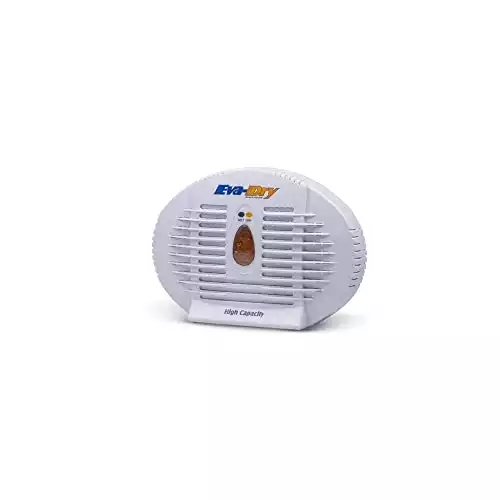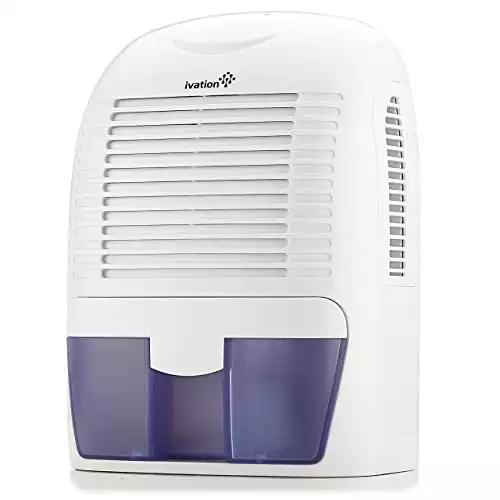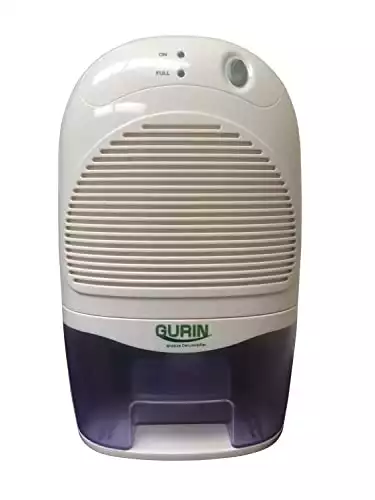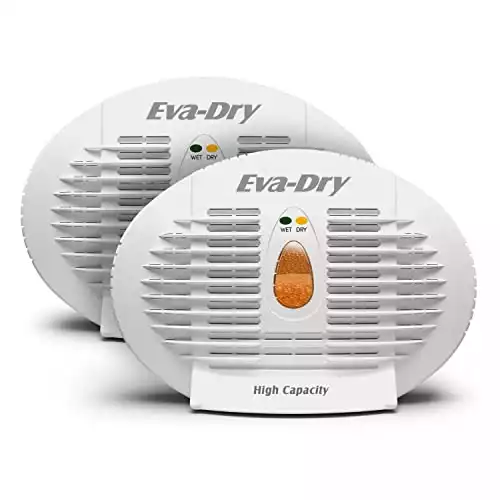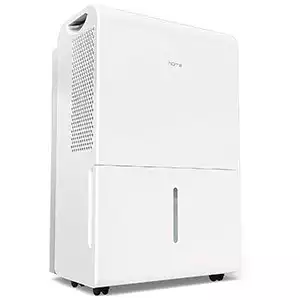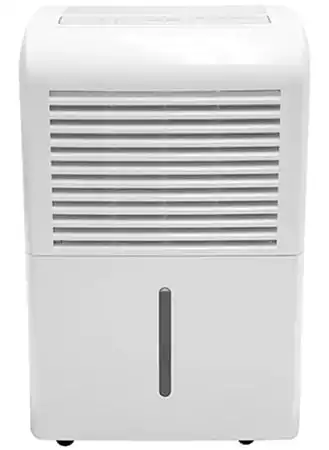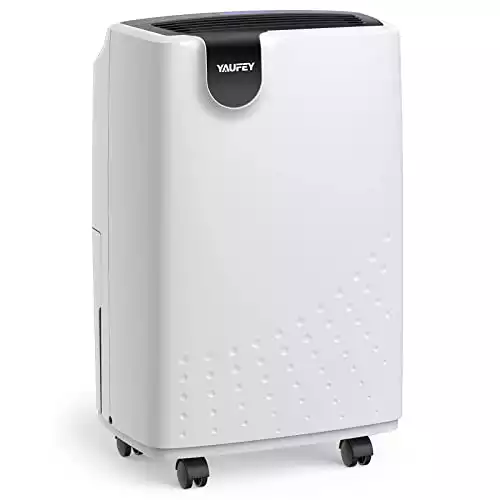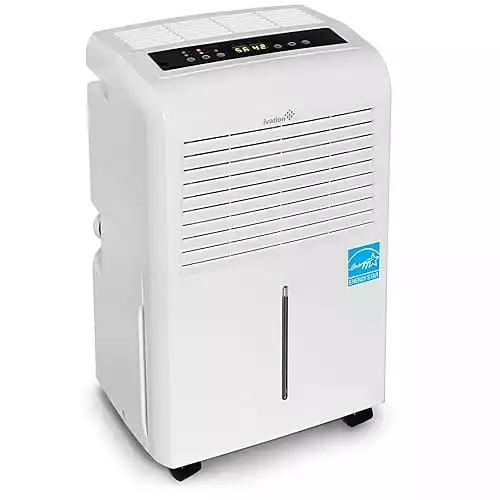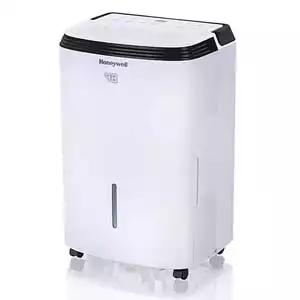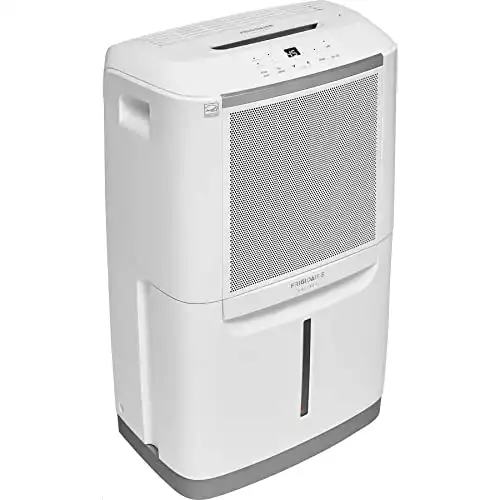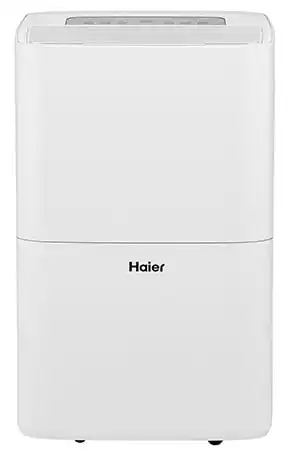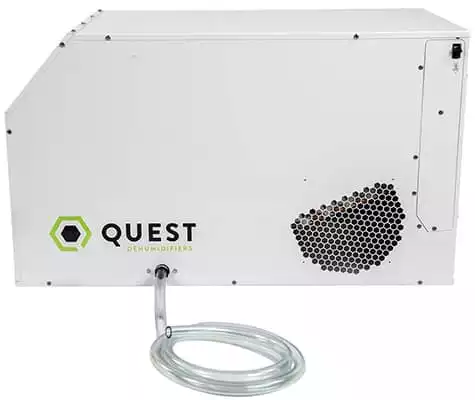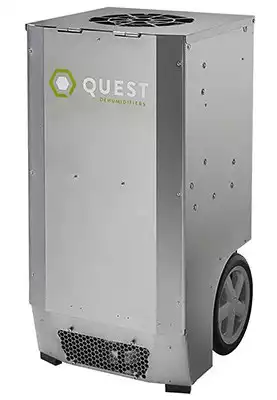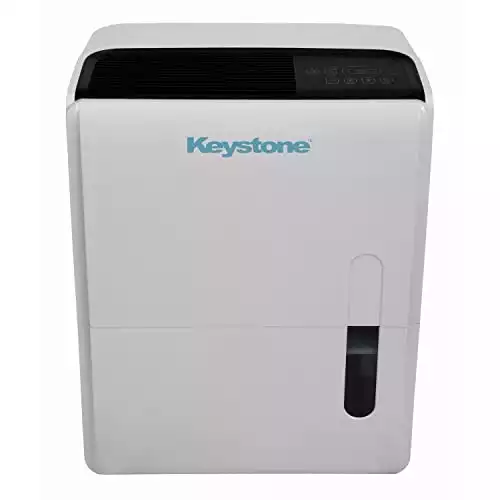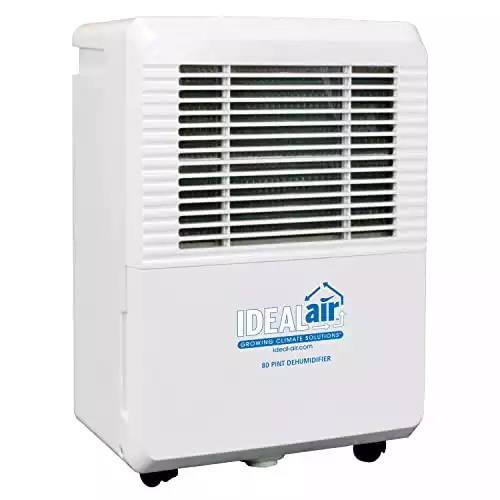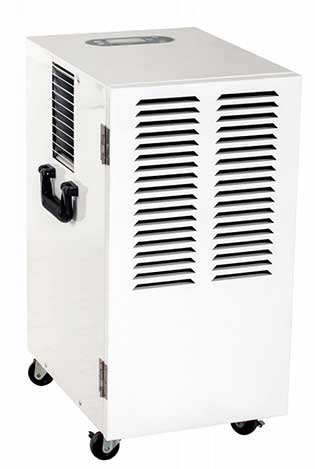The Takeaway:
1. For Small Grow Tents: Eva-Dry E-500
2. For Medium Grow Tents: HomeLabs 50 Pint Dehumidifier
3. For Large Grow Tents: Honeywell 70 Pint Dehumidifier With Pump
4. For a Grow Room & Tent: Quest Dual Overhead 105 Pint Dehumidifier
Grow tents and grow rooms are fantastic ways to grow almost any type of plant in a carefully controlled environment all year round. But there’s a catch. Note the words “carefully controlled environment.”
Plants growing in the great outdoors get light from the sun and water from rain. If you’re growing indoors, you must simulate the natural growing environment for your plants or, even better, optimize it for the types of plants you’re growing. That necessarily requires active participation on your part to ensure that your plants are getting exactly what they need to thrive and that you’re removing elements from your controlled growing space that could potentially be harmful to your plants.
Among other things, it’s going to be on you to control things like:
If any of these elements are out of balance and not optimized for the types of plants you’re growing, you’re almost certainly going to be disappointed in your harvest.
Controlling all of these factors is well beyond the scope of this roundup. Here, we’ll focus specifically on dehumidifiers and their ability to control the relative humidity of your growing space.
To that end, we’ve scoured the market on a quest to find the very best dehumidifier for a grow room on the market today and have found and declared a few different winners. Ultimately, we couldn’t declare a single winner because grow tents and rooms come in all shapes and sizes and what’s optimal for a 2’x2’ grow tent is completely inadequate to a 10’x10’ (or larger) room.
We’ll announce the winners and their contenders, but first, let’s briefly discuss our selection criteria.
Our Selection Criteria
In evaluating products in the various categories above, we looked at a number of different things, including:
Each of these elements is important in its own way but taken together, they provide a good composite view of what each model is capable of and give us some understanding of each machine’s overall value to you, the grower.
Unfortunately, the perfect dehumidifier for a grow room does not exist. That’s because there are a number of important elements to consider, and each person is going to place a different level of value and importance on those factors than the next person will.
Why Relative Humidity (RH) Matters
No matter what you’re growing, plants need water. Relative humidity (RH) is the amount of moisture in the air. If the air is too humid, you’ll facilitate the growth of mold on your plants, which will kill them. Too little humidity and your plants won’t be getting the water that they need. As a grower, your goal is to find the sweet spot that keeps your plants happy.
The question, then, is what’s the sweet spot? The answer depends on a number of factors, including what plants you’re actually growing and their relative age, but here are a few general guidelines you can use as a starting point:
Seedlings
At this stage in any plant’s life, it’s growing rapidly, and of special significance, it is developing the root structure that will support the plant for the rest of its life. Plants at this stage require relatively higher humidity to thrive, generally in the 70% – 75% range. Low humidity at this stage will stunt the growth of your plants.
Vegetating Plants
By this point, your plants have fully developed root structures, but they still require an assist from their leaves to properly absorb water. As such, relatively high humidity is still of some benefit to plants at this stage, and a humidity range of 50% to 70% is ideal.
Flowering Plants
This is where mold and mildew can begin to be a problem, and indeed, a direct threat to the health of your plants. Lower humidity is called for at this stage, and the optimal range will be somewhere between 40% to 50% humidity. High humidity at this point and beyond will lead to mold growth.
Harvesting
Late-stage, lower humidity is better. Here, your target should be in the range of 45% to 50% humidity.
Again, treat these as general guidelines. The specific numbers will vary depending on exactly what it is you’re growing. The main point is simply this: Maintaining tight control over the relative humidity of your growing space is incredibly important, and the right dehumidifier for a grow room is critical to that effort.
Temperature & Humidity
Temperature is also a factor here because temperature and humidity go hand in hand. It’s not really possible to talk about one without at least making mention of the other. With that in mind, here are general temperature thresholds to keep firmly in mind:
Ultimately, these things matter because water is the means by which nutrients move from a plant’s root system and into the rest of the plant. Not enough water means that your plants will be starved for the nutrients they need, which is why you’ll see stunted growth.
The roots of your plants will wind up hoarding what water there is, which will overload them with an excess of nutrients that never make it to the rest of the plant. It also makes your plants more likely to be infested with spider mites and other insect infestations, and you may see a white, powdery mildew forming on them.
Conversely, as plants mature, exposure to too much water and humidity can lead to problems that are every bit as dire. Simply put, too much water will drown the roots of your plants, preventing them from being able to absorb gasses from the soil. At that point, it doesn’t matter how many other factors you get right; the show’s over.
How to Calculate Dehumidifier Size For a Grow Room
Whether your question is ‘What size dehumidifier do I need for my grow room?’ or ‘What size dehumidifier do I need for my grow tent?’ the answer comes down to how much water you’re feeding your plants on a daily basis and how many plants you’ve got. Those are the key pieces of information you’ll need when properly sizing a dehumidifier for your growing space.
Most gardening experts recommend 0.623 gallons of water per square foot per week. While this varies depending on exactly what you’re growing, it’s a useful benchmark and can give you some hard numbers to work with.
Start by figuring out how much growing space you have and remember that you may have more than you think. For instance, ostensibly, a 2×2 grow tent has 4 square feet, but if you’re planting in tiers and using the vertical space to get more plants in the tent, your effective growing space (and thus, your water needs) will be higher.
Remember, there are 8 pints to a gallon. Also remember that some plants wind up giving back almost all the water you feed them, while others (including most vegetables) tend to hold onto much of the water you give them. So again, it pays to have a deep understanding of what you’re growing and how much water they need to thrive.
Hence, the Formula – Dehumidifier Calculator For a Grow Room (Or Tent)
(Growing space in square feet * 0.623) = Weekly Water Requirement
Weekly Water Requirement/7 = Daily Water Requirement (in gallons)
Daily Water Requirement (Gals) * 8 = Pints of Water
With this last figure being the maximum extraction capacity you’d want to shoot for, and again, understanding that there’s runoff and other factors to consider which may shade your final figure. For instance, a single cannabis plant requires about 1.4 pints of water per day, on average—modified by local conditions–so if that’s what you’re growing, then your figures will be different.
Generally speaking, though, you want an extraction capacity equal to the amount of water you introduce into the system.
Your formula for how to size a dehumidifier for a grow room can get more complicated than this and try to take into account the amount of runoff that never actually makes it to the plants (and there’s always some). But where a dehumidifier’s capacity is concerned, you generally want to overshoot what you actually need by at least a bit.
There is a tradeoff, of course. If you wildly overshoot your extraction needs, then you’re paying a premium for capacity you’ll never use. On the other hand, if you cut it too close to the bone, then you’ll find yourself in a situation where your dehumidifier in a grow room is running all the time and struggling (or simply failing outright) to keep pace with the water you’re introducing, which means the humidity level won’t drop by the amount you’re hoping.
Worse, with the machine running on a constant basis, you’re introducing heat to the system, which could cause the temperature to creep up and out of your ideal band. That’s part of your challenge: Keeping all the factors critical to the success of your growing space in balance!
Other Things to Consider
What Can I Do If My Dehumidifier is Making My Grow Room Hot?
This is or can be, a genuine problem. After all, most dehumidifiers rely on motors to do their work and will give off heat. Your grow tent or grow room is a confined space, and absent a robust ventilation system; the heat will get trapped in the room and increase the temperature over time.
There are a number of possible fixes here if you start seeing this happening. These include things like:
Each person’s setup is different, and there’s no one right answer here. It comes down to experimentation and finding the best mix of technologies for you to keep the conditions inside your grow tent or room in balance.
What is the Best Place For a Dehumidifier in a Grow Room?
As with everything else, the answer is “it depends.” There are a number of factors to consider.
Check the Manual
First and foremost, you want to be sure that wherever you put your dehumidifier, you’re abiding by the manufacturer’s guidelines where proper ventilation is concerned. This varies from one unit to the next, so be sure to check your user manual for guidance. Generally speaking, you’ll want to allow at least 18” of clearance between the air intakes and the nearest wall or major obstruction.
Number of Dehumidifiers
In addition to that, there’s the question of how many dehumidifiers you’re deploying in a given space. If you’re just deploying one, then placing it in a central location inside the space is good, and placing it high is even better if the unit has a gravity drain. If you’re deploying several, then you’ll want to evenly space them and arrange them in such a way that you’re providing good, even coverage throughout the space.
Zones with Different Humidity Levels
Note that if you have an especially large grow room, you can, by strategically placing your dehumidifiers, create zones that have slightly different relative humidity levels. That’s useful if you’re growing plants in varying stages of maturation.
Dealing with the Extracted Water
Broadly speaking, dehumidifiers are designed around one of three basic strategies for dealing with the water they extract.
Reservoir
All dehumidifiers come with a reservoir or some means of trapping and storing the water they extract. The limitation with that approach is that you have to periodically empty the reservoir to keep the extraction going, which means babysitting the process.
Drain
Once you start looking at dehumidifiers that extract 30+ pints of water per day or so, you’ll start seeing many that come with a simple gravity drain system. These units still have a water collection reservoir, but they also come with a drain port.
Put a hose in the drain port and let gravity route the water through the hose and out of your life. Where you direct the water is up to you. A sink or tub drain, a rain collection barrel, your flower garden, wherever. That part’s up to you.
Obviously, there are some limitations to this approach, though. Gravity drains are a little fickle because, of course, the hose has to point “all downhill.” You can’t have it going down, then up, then back down, or winding around in circuitous paths, you’ve pretty much got to have a straight downhill path for the water to flow, which means you’ll probably need to set your dehumidifier high (on a shelf, or hang it some way or another) and let the water flow down and away.
Pump
The best dehumidifiers come with a built-in pump that will route the water out of the area and out of your life. These cost a bit more, but are a whole lot more convenient and give you a great deal of flexibility.
If you’re only extracting a few pints of water per day, there’s not much incentive to, nor gain in trying to reclaim that little bit of water to reuse on your plants. The more water you’re extracting though, the more attractive that option becomes.
Reusing the Extracted Water
If you decide you want to reuse that water, you’ll need to take a few precautions, though. Cheaper dehumidifiers tend to leach out copper and aluminum, and there’s a very good chance that over time, mold will start growing inside the system.
You can combat the first problem by investing in a higher-end unit and the second by regularly inspecting and cleaning your unit. Yes, it’s more expensive and labor-intensive, but if you’re extracting a ton of water and want to reuse it, that’s what it takes to make sure you’re not poisoning your plants!
Now that we’ve discussed the particulars in some detail let’s take a closer look at our winners in the various categories.
Best Dehumidifier For Small Grow Tents
|
4.3
|
4.1
|
3.9
|
|
$69.95
|
N/A
|
N/A
|
|
|
|
|
|
|
|
Highly recommended. They last up to ten years, making them a superb value.
|
In our view, this is the second-best mini dehumidifier for a grow tent. As long as you keep its inherent limitations in mind, we recommend it.
|
As long as you keep its inherent limitations in mind, we recommend it.
|
- Incredibly inexpensive and long-lasting. Great for deploying in packs! Hands down the best cheap dehumidifier for a grow tent.
- Tiny. Individually they don’t absorb much water so you’ll need to buy at least three (fortunately, they’re a third the price of comparable dehumidifiers)
- Uses extremely efficient Peltier technology. Auto shutoff prevents reservoir overflow. Better than average product quality for an import. Good reputation for customer service and support.
- Peltier technology is very efficient, but slow.
- Uses extremely efficient Peltier technology. Auto shutoff prevents reservoir overflow. Gurin’s products are a cut above and the company puts some effort into customer service.
- Peltier technology is very efficient, but slow.
Our Pick: Eva-Dry E-500
Recommended For: Anyone with modest moisture problems to deal with. These are fantastic.
Summary
The Eva Dry E500 is small, unobtrusive, effective. Recommended for anyone with modest moisture problems to deal with. These are fantastic.
At first glance, the E-500 might seem like an unlikely pick to win top honors in this category. After all, it’s tiny, and it doesn’t extract much water. Appearances, though can be deceiving.
Cost-Effective
First and foremost, this unit costs about a third of what its peers will run you, so you can buy three for the price of one of any of the others. When you do, the amount of water extraction equals out. These little guys work fantastically when operated in packs! In fact, why the company doesn’t sell a 3- or 4-pack of these, we’re not quite sure.
Quality and Warranty
Second, the big problem with most of the low-cost, small-space dehumidifiers is the fact that they’re Chinese imports and made with lower quality components that just don’t last very long. Best case, you can expect them to provide about two years of service, and then you’re going to simply toss them out and replace them.
That’s not the case with the E-500. The simple heating element is the only thing that could be construed as a mechanical part, and it doesn’t move, so it’s not likely to break, and the silica beads that absorb the moisture can be used over and over again. That’s why these simple machines have an impressive five-year warranty and can last up to a decade.
Capacity
When you take that into account and factor in the money you’ll save by not having to purchase new mini-dehumidifiers every couple of years; it’s awfully hard to argue against these handy little units. The only real downside is that they can be easily overwhelmed. These aren’t the units you want if you have a medium-sized or larger grow tent, or even a modestly sized grow room.
On the other hand, if you have a musty closet, a bathroom that’s consistently muggy, or if you need a low-cost dehumidifier for a grow closet, these little units are worth double or triple their weight in gold. They’re simple, long-lasting, and effective. We recommend this model, provided you take care not to overwhelm it (which is fairly easy to do)!
Runner-Up: Ivation GDM-30
Recommended For: RV owners, indoor growers with very small grow tents or few plants that don’t require much water. Also good for smaller rooms with minor humidity issues.
Summary
A very basic, small capacity dehumidifier. Ivation GDM30 Dehumidifier is recommended for RV owners, indoor growers with very small grow tents or few plants that don’t require much water. Also good for smaller rooms with minor humidity issues.
Design-wise, the Ivation GDM-30 is about as simple as it gets. It’s got a delightfully small footprint, is very lightweight, and only extracts a modest amount of water every day. It is a highly efficient little machine, though, utilizing Peltier technology to handle the moisture extraction function.
Without wading too deeply into the technical details, Peltier technology works by creating a temperature differential inside the Peltier module in the machine, and it is this differential that actually extracts moisture from the air.
As we said, it’s an incredibly efficient and effective design, but there’s a catch: It’s also really slow. Don’t expect to see immediate results if you buy this machine. It will get the job done, but it’ll do it at a snail’s pace, which is ultimately why it didn’t win top honors.
Ivation is a good company, and although they import their products from China for resale, the quality of their wares is generally a cut above from what you see from most Chinese imports.
This is a function of a few different factors working in tandem. First, the overall quality of Chinese manufacturing has been steadily increasing in recent years anyway. Second, Ivation demands higher quality from their manufacturers, and third, Peltier technology is simple, robust, and effective.
Even if the quality of the materials is somewhat low, the tech itself is rock solid.
Put those elements together, and Ivation’s mini dehumidifier is a pretty good little machine. Granted, it’s very easy to overwhelm a tiny unit like this, so it is at its most effective in small, tight spaces or tiny grow tents. As long as you’re mindful of this unit’s limitations, however, it will serve you well and reliably and is a very good dehumidifier for a small grow tent. On that basis, we provisionally recommend it.
Also Great: Gurin DHMD-310 Mid-Size Electric
Recommended For: Anyone with a small growing space, a single room, or an RV, who finds themselves in need of a means of controlling humidity.
Summary
The Gurin DHMD-310 is a smallish, easy-to-use dehumidifier. Recommended for anyone with a small growing space, a single room, or an RV, who finds themselves in need of a means of controlling humidity.
Gurin is a smaller brand and not especially well-known, but they’ve been in the business for a long time, and they have a reputation for making consistently good products and for actually putting some effort into their customer service.
That’s noteworthy because so often, the smaller brands pay only lip service (if that) to the idea of customer service and support. Gurin goes out of their way to do a good job here and that, as much as anything, sets them apart and makes them well worth considering.
Both aesthetically and in terms of feature set, the Gurin 310 is virtually identical to the slightly more expensive Ivation dehumidifier we talked about just above, and like the Ivation, it utilizes Peltier technology to handle water extraction.
That’s both good and bad for the same reasons we discussed above. Good because Peltier technology is rock solid and reliable, which makes this little dehumidifier much better quality than you might otherwise expect. Not so good because it is slow. Like the Ivation, don’t expect this little guy to win any water extraction speed contests. You’ll be disappointed.
On the other hand, it’s quiet, efficient, and effective. If you’re only dealing with a small space and don’t have to worry about extracting too much water from the air, a little unit like this is perfect, and given Gurin’s reputation for quality and customer support, it’s a safe choice and an excellent budget option if you’re in the market for something like this.
A solid, small dehumidifier for a grow tent and a great alternative to the Ivation if that one doesn’t work for you for one reason or another.
Best Dehumidifier For Medium Grow Tents
|
4.4
|
4.4
|
4.3
|
|
$249.99
|
N/A
|
$159.99
|
|
|
|
|
|
|
|
In our view, this is the best dehumidifier for a 5×5 grow tent. Recommended.
|
Recommended.
|
We regard this as being the best dehumidifier for a 4×4 grow tent, where 50 pints per day might be more than you need. Provisionally recommended.
|
- Simple, rugged, robust design. Gravity drain.
- You’ll need to invest in a few extras to get full use out of it (extension cord, drain hose, and a hygrometer if you’re a grower).
- One of a relatively few dehumidifiers in its size class that comes with a dedicated pump. Full-featured and offered by a company with an excellent reputation for customer service.
- Pricey
- Surprisingly good quality. Full-featured. Gravity drain.
- Offered by a smaller brand, not as well known in the US.
Our Pick: HomeLabs 50 Pint Dehumidifier
Recommended For: Anyone with a moderate humidity issue. Growers with small grow rooms or medium-sized grow tents.
Our overall winner in this category comes to us from HomeLabs. While not a giant in the industry, they have an excellent reputation for both quality and customer support, and their 50-pint dehumidifier is full-featured and expertly designed.
Specifications
Before we dig into the specific features it has on offer, let’s begin by taking a quick look at the basic stats that drive and define this model:
One thing for growers to be mindful of here is the fact that this unit utilizes a bit more energy than many comparably sized units, and it will add some heat to whatever growing space you’re using it in. You’ll need to plan around that, and be sure to include some strategy for mitigating the heat.
If you don’t, you’ll find yourself in the unhappy position of solving for your humidity issue, only to discover that the temperature in your grow space is no longer ideal.
Power Cord
Also note that depending on the size of your grow tent or room and where you want to place the unit, you may have to break out a heavy-duty extension cord to get it where you want it, as the power cord is likely to not be long enough in a significant percentage of situations.
No Drain Hose
We’re actually fine with the fact that HomeLabs opted not to include a drain hose with this model because, in our experience, most companies that offer one tend to offer short-ish lengths of hose anyway, prompting you to have to go out and buy one long enough to actually be useful.
Humidistat
The built-in humidistat is fairly accurate, and you’ll find that the values displayed on the dehumidifier’s control panel track pretty closely to the values your hygrometer is reporting, and you’ll start seeing results fairly quickly.
Warranty
It’s an impressively powerful and capable unit with a 2-year warranty, which the company will extend by an additional six months if you register your product within 14 days of your purchase.
Quality
It’s worth mentioning that HomeLabs designs its products in the US and outsources manufacturing to China. The overall quality isn’t quite as good as you find in dehumidifiers manufactured in the West, but HomeLabs holds their manufacturer to high standards, and the quality is better than you typically see from Chinese imports.
Features
Feature-wise, you’ll find that is has the basics well-covered and includes:
Air Filter
It also comes with a washable filter that will help to clean the air, removing dust, mold spores, pet dander and the like. Just remember to pause the unit so you can wash the filter every couple of weeks, and it will serve you quite well.
For best results, you’ll want to mount this unit on a shelf or workbench to create some height, which will allow the gravity drain to function more effectively.
Capacity
If you opt not to make use of the gravity drain, the unit will require a bit more babysitting, and in high moisture environments, you’ll find that you have to empty the reservoir 3-4 times a day. That’s not bad, considering that some units on the market today are saddled with relatively small reservoirs relative to their extraction capacity and require you to empty it 8-10 times a day.
Overall, this is a super strong unit and an ideal choice for a 4’ x 4’ or 5’ x 5’ grow tent, or even a modestly sized grow room, depending on how many plants you’re working with and how much water you’re feeding them on a daily basis. It’s well-deserving of top honors here, and we absolutely recommend it.
Runner-Up: EdgeStar 50 Pint Dehumidifier
Recommended For: Anyone with a moderate humidity problem who wants an easy-to-use, hassle-free dehumidifier.
Summary
The EdgeStar 50 Pint Portable Dehumidifier is a simple, effective design for hassle-free operation. Recommended for anyone with a moderate humidity problem.
EdgeStar actually has a lot in common with our top pick. They’re a smaller American company that’s been in the business for a while and they’ve got a better than average reputation when it comes to both the quality of their products and the level of customer service and support they provide.
Also, like HomeLabs, they design their products here in the US, then outsource their manufacture to China to help keep costs low. In that respect, the same caveats we mentioned with HomeLabs apply here.
This particular model has a lot to offer and only narrowly lost out to the HomeLabs dehumidifier. Among other things, it has the distinction of being the only dehumidifier in this section of our review that comes with a dedicated pump, which makes it an extremely convenient, mostly hands-free unit that doesn’t require a lot of babysitting.
Specifications
Before we go further, let’s do a quick review of the unit’s basic stats. Here they are:
Power Usage
The big thing to talk about here is the power usage. This little unit uses an almost shockingly modest amount of power, especially given that it has both a compressor and a dedicated pump, and note that it uses significantly less power than our top pick. If temperature control and convenience are the main things you’re after, this unit could easily replace the HomeLabs dehumidifier as your top pick.
Drain Hose
A smaller point, but a very nice touch on the part of EdgeStar, is the fact that this one comes with a drain hose that’s long enough to be useful, so there’s nothing else you’ll need to buy to put it into service.
Smart Features
Feature-wise, this unit is identical to our top pick, with a two-speed fan, auto shutoff, and auto-defrost. It also comes with two modes of operation; you can either set the unit to run for X number of hours or set a target humidity level for it to reach.
Humidistat
The on-board humidistat offers about the same level of accuracy as the one on our top pick too, and it has the added convenience of having the dedicated pump, which isn’t nearly as fickle as a gravity-drain system.
Filter
In addition to that, it includes a washable filter so it returns air to the space you’ve got it in with fewer pollutants than were in it when it entered the machine. Given all that, you might wonder why this unit didn’t win top honors.
The answer comes down to two things. First, EdgeStar doesn’t have quite as good a reputation as HomeLabs (close, but not quite), and second, the addition of the dedicated pump adds significantly to the total cost of the unit. You’re paying a hefty premium for convenience, and not everyone is going to want or be able to afford that, which makes the HomeLabs offering slightly superior in our view.
Even so, if you’re looking for a great dehumidifier in this size range and you want one that has a dedicated pump, this is an awesome choice, and this model is well-deserving of a second-place spot in this part of our roundup review. It’s an excellent, highly convenient dehumidifier for a 4’ x 8’ grow tent with a high planting density, and could easily serve larger grow tents with lower plant densities and water use. We recommend it.
Also Great: Yaufey 30 Pint Dehumidifier
Recommended For: Anyone with a light to medium humidity problem. Perfect for people with smallish to medium-sized indoor growing spaces.
Summary
The Yaufey 30 Pint Dehumidifier is surprisingly robust and full-featured, this little dehumidifier doesn’t disappoint! Recommended for anyone with a light to medium humidity problem. Perfect for people with smallish to medium-sized indoor growing spaces.
If fifty pints per day of water extraction is more than you need, and you’re looking for a simple, surprisingly well-made 30-pint model, then the Yaufey belongs on your shortlist of options to consider. Like the other models featured in this segment of our roundup review, Yaufey imports their wares from China for resale here.
We won’t rehash why that matters except to say that the usual caveats that go along with that apply. Even so, the company has a better than average reputation where both overall product quality and support are concerned, which makes their dehumidifiers a cut above what you find offered by the legions of low-cost import models offered elsewhere.
Specifications
As we’re in the habit of doing, let’s start with a quick review of the basic stats that define this model:
A Few Things to Consider
There are a couple of noteworthy things about these numbers. First and foremost is the modest power requirements. While it’s true that this unit will add some heat to any grow space it’s used in, the amount is quite modest and easily countered.
Second, you’re definitely going to want to use the gravity-drain with this unit because the reservoir is somewhat undersized, and if you don’t, you’re going to find yourself having to empty the bucket on a regular basis which is going to mean keeping a close eye on it.
Unfortunately, the included drain hose is too short to be useful in a significant percentage of cases, so you’ll probably need to invest in a long one, and while you’re at it, if you don’t have a spare heavy-duty extension cord, get one of those too.
The good news is that since this model is delightfully low-priced, you’ll have plenty of money left over for those extras.
Features
Feature-wise, this is a robust little unit with all the same features that our top pick has on offer (auto shut-off when the reservoir is at capacity, auto-defrost, an accurate build-in humidistat, and a two-speed fan). It’s also got a basic, washable filter so it will do something to pull pollutants out of the air, in addition to the water it extracts.
Warranty
The standard warranty on this unit is one year, but if you register your product within 14 days of your purchase, the company will extend it to two. That’s pretty good for a Chinese import and speaks to the higher than average product quality you get from this brand.
It’s quiet, capable, and it sips power. It’s a little small for us, but it’s one of the best dehumidifiers for small grow tent with a high density of plants, or a lower-density medium sized indoor growing space. On that basis, we provisionally recommend it.
Honorable Mention: Ivation 30 Pint Dehumidifier
Recommended For: Anyone with a modest humidity problem in homes, boats or RVs. Growers with smaller grow rooms or medium-sized grow tents.
Summary
The Ivation 30 Pint Energy Star Dehumidifier is a well-designed, full-featured dehumidifier for general use. Recommended For: Anyone with a modest humidity problem in homes, boats or RVs. Growers with smaller grow rooms or medium-sized grow tents.
Denver-based Ivation wins another spot in our roundup review with their 30-pint per day design. We regard it as marginally weaker than Yaufey’s model, but functionally similar.
Specifications
We’ll start by reviewing the basic stats of the model and go from there:
Reservoir & Drain
In comparing these numbers with the Yaufey 30-pint, it reveals why that model narrowly beat it out. Although the Yaufey has a smaller reservoir and a longer included drain hose, those are largely cosmetic issues that are easily solved by other means.
You can buy a drain hose of whatever length you desire for a song, and both units feature gravity drains, which limits the importance of the reservoir size (assuming you’re making use of the drain).
Power Usage
Given that, the headline here is power usage, and over time, the Yaufey will save you money while extracting the same amount of water. That’s a big deal because it directly impacts your budget, and ultimately why this unit narrowly lost out to Yaufey.
Features
Feature-wise, it’s virtually identical with Yaufey, with a two-speed fan, auto-defrost, auto-restart, and two modes of operation (timed operation or humidity target).
Humidistat
That brings us to another point of weakness in this unit’s design that’s worth bringing to your attention. The on-board humidistat is somewhat less accurate than you’ll find on many other models, and you’ll often note a discrepancy of up to 15% between what the machine is reporting and what your digital hygrometer is reporting. While that’s not ideal, it’s easy enough to plan around and compensate for once you get a feel for the unit.
Fill Sensor
Back to features, you’ll also find a fill sensor in the reservoir and an auto-shutoff feature that prevents messes in the event that your gravity drain gets fouled or clogged, or you’re not using it and not paying close attention to the fill level of the reservoir.
Filter
Finally, you’ll find a washable filter that helps purify the air in whatever space you place the unit. It’s not a great filter, but it will handle the basics well enough, and as we mentioned, it’s washable so you won’t have to spend money periodically to replace it if you give it a thorough rinse every couple of weeks.
Overall, we regard this unit as a good unit that sadly falls short of greatness. Even so, Ivation is a respected company with a good reputation, and if the other models we’ve mentioned in this section aren’t what you’re looking for, it’s an excellent fallback option. We provisionally recommend it.
Best Dehumidifier For Large Grow Tents Or Small/Medium Sized Grow Rooms
|
4.6
|
4.5
|
4.5
|
|
$319.99
|
N/A
|
N/A
|
|
|
|
|
|
|
|
Best dehumidifier for 10×10 grow room. Well worth the extra money. Highly recommended.
|
Very good, cheap dehumidifier for smaller grow rooms. Recommended.
|
One of the best small dehumidifiers for grow rooms, despite being a little power hungry. Recommended.
|
- An expertly designed, full-featured humidifier, offered by one of the finest and most respected companies in the industry.
- A little pricier than its peers.
- Well-priced and offered by a great company. On balance, this is a very solid machine.
- There are a few little design glitches we hadn’t expected to see in a machine offered by such a great company. Nothing deal-breaking, but slightly disappointing.
- A solid, capable machine by any reckoning. Full-featured and offered by a company with an excellent, longstanding reputation.
- Power hungry, relative to its peers.
Our Pick: Honeywell 70 Pint Dehumidifier With Pump
Recommended For: Anyone. It’s a little more expensive than most of its peers, but you’re paying for quality and performance.
Summary
A masterfully designed and capable dehumidifier capable of solving moisture problems in medium-sized rooms, basements, large grow tents, or small grow rooms. It’s a little more expensive than most of its peers, but you’re paying for quality and performance.
This is an unquestionably great machine, offered by a legendary company. Honeywell seems to excel at every market they decide to enter, and this robust, well-designed dehumidifier is an excellent example of their work. It’s expertly designed from top to bottom.
Specifications
Before we get into the particulars, here are the basic stats that define the model:
The dimensions of the case may be small, but this is a hefty little unit, weighing in at nearly fifty pounds thanks to the presence of both its powerful compressor and the dedicated pump. It’s got an average-sized reservoir, but given that it comes with a dedicated pump, the size of the reservoir shouldn’t be a factor unless you find yourself in the rare circumstance of not being able to make use of the built-in pump you paid extra for, which should be very rare indeed.
Power Cord
The power cord’s on the stubby side, but that’s easily remedied by adding a heavy-duty extension cord and is a problem with almost every dehumidifier on the market today, regardless of who makes it.
Drain Hose
One thing we really like is the fact that Honeywell included a drain hose long enough to be genuinely useful.
So often, when companies bother to include one, they give you so little that it makes you wonder why they bothered to include it at all. In this case, Honeywell included one that’s as long as the pump is rated for, which is superb. It’s a small detail, but one of those nice finishing touches that you’d expect to see from such a well-respected company.
Control Panel
The unit’s control panel is as intuitive and as expertly designed as the rest of the machine, and it will only take you a matter of minutes to master its use. It’s got all the features you’d expect in a full-featured dehumidifier, including two fan speeds, an auto-fill sensor in the tank, and an auto-shutoff if the tank gets full and the pump isn’t working, or the drain hose is fouled for some reason.
You can choose to operate the machine by setting a run time of X hours, or by setting a target humidity level, allowing the machine to run until it hits your target. You’ll find that the built-in humidistat is fairly accurate, and the values it reports tracks closely to the digital hygrometer you’ve probably already got.
The unit also features an auto-restart function and comes with a washable filter that’s capable of filtering out most types of common pollutants in the area you set the machine up in.
Aside from keeping the filter clean, there’s really not a lot to be done, maintenance wise. Just check-in at periodic intervals to make sure everything is still functioning as you expect it to, and you’re all set.
One thing you’ll really appreciate about this unit is the fact that since it’s built using high-end components, you won’t have to worry much about copper or aluminum leaching into the water you extract, which means you’ll be able to recycle and reuse it later on your plants.
Sure, it’s a little more expensive than its peers, but you’re paying for quality, and in our view, it’s well worth the extra money. We highly recommend it.
Runner-Up: Frigidaire 70 Pint Dehumidifier With Pump
Recommended For: Anyone who’s on the lookout for a convenient dehumidifier, offered by one of the big names in the business.
Summary
An excellent, robust dehumidifier offered by a legend in the home appliance industry. Recommended for anyone who’s on the lookout for a convenient dehumidifier, offered by one of the big names in the business.
Frigidaire is no Honeywell, but they’ve been a mainstay in the American home appliance market forever and they have an outstanding reputation for making quality products. This is a very good dehumidifier for grow rooms by any reckoning and is well-deserving of a second-place spot on this part of our list but there are a few minor issues with this model’s design that we were both surprised and saddened to see that kept it from the top spot.
Specifications
We’ll get into those in just a moment. First though, here are the basic stats for this unit:
Drain Hose
Like our top pick, Frigidaire deserves kudos for including a drain hose that’s long enough to be useful with their dehumidifier. That’s something of a rarity, and we always appreciate it when we see it.
Power Usage
The headline number from these basic stats, though, is the power usage. At 745 watts, this unit uses less power than any of its peers. Granted, if you place it in a small growing space, it’s still going to add heat, but it will add less heat than just about any other comparably sized unit on the market, and it’ll cost you less to use. Those are good things, and the unit’s energy efficiency is one of the major reasons this model placed a solid second in this part of our review.
Features
Feature-wise, it’s got everything you’d expect from a dehumidifier in its class and in fact, offers the same feature set as our overall winner (auto-defrost and restart, fill sensor for the tank and auto-shutoff, two fan speeds and two modes of operation (time or humidity target).
Also, like our top pick, it has a washable filter that traps dust, pollen, pet dander, and the like, returning air to your growing space cleaner than when it went into the unit.
A Few Things to Consider
Those are all good things, but as we said at the start, this unit has a few small design problems that are honestly surprising in a machine offered by an experienced company like Frigidaire.
It’s a little louder than it needs to be. The design of the carrying handle is substandard, and the user manual is relatively poorly written and more frustrating than helpful.
It probably sounds like we’re being nitpicky, and in a way, maybe we are, but these kinds of issues are things you expect to find in companies that are brand new to an industry and still finding their footing. We just expected more from a major player like Frigidaire, so those minor issues really stood out to us.
None of those things are deal-breakers, obviously, but they do detract from what is otherwise an excellent dehumidifier. Despite those minor things, we absolutely recommend this model. It’s not top-tier, but it is very, very good.
Also Great: Haier 70 Pint Dehumidifier With Pump
Recommended For: Anyone with a medium-sized moisture issue, looking for a dehumidifier with a built-in pump for maximum convenience.
Summary
A well-designed, full-featured dehumidifier, offered by a stellar company. Recommended for anyone with a medium-sized moisture issue, looking for a dehumidifier with a built-in pump for maximum convenience.
Rounding out our top picks in this section is an excellent 70-pint dehumidifier by another major player in the industry, Haier. While you’ll find a large number of off-brands competing at this level, they just can’t hold a candle to the quality offered by the industry’s giants, and as such, they just didn’t perform well enough to make an appearance on the list in this segment of the market.
Haier isn’t as well-known as Frigidaire, but they are every bit as respected, and they have a stellar reputation for both the quality of their products and the care and attention they give to their customers.
Specifications
Before we talk about the specifics, let’s do a quick review of this model’s basic stats:
We certainly didn’t hold the fact that Haier opted not to include a drainage hose with their product, but we will note that both of our other two top contenders not only included one but included a hose long enough to be genuinely useful.
Haier could have easily matched them on that front, but a hose is a super inexpensive addition, so we can’t really find fault or ding them for not including one.
Power Usage
On the other hand, check out the power usage for this unit! That’s on the high side, and it means that this model has a higher total cost of ownership over the course of its life than most of its peers. That’s not great, but we should add that the difference in power consumption isn’t a huge one, so it’s not like it will add an incredible amount to your power bill each month.
Even so, where dehumidifiers are concerned, using less power is always better, both because it doesn’t have as great an impact on your light bill, and it doesn’t introduce as much heat into your growing space. The heat issue is by no means an insurmountable problem, but it’s something you’ll want to take into account if you decide to invest in this model.
Features
Feature-wise, this unit is a carbon copy of the other two units that we talked about above. You’ll find a two-speed fan with two modes of operation (set number of hours or humidity target), along with:
Humidistat
The built-in humidistat is adjustable in 5% increments and you’ll find that it reads within +/-5% of the value your hygrometer displays.
Haier’s a good company and they’ve produced a great product in the form of this rugged little dehumidifier. It’s a workhorse and the main reason it didn’t earn a higher spot in our rankings is the fact that it’s a little power hungry relative to its peers. If that’s not an issue for you, this is an excellent choice that will serve you well.
Best Dehumidifier For a Grow Room & Tent (Largest Operations)
|
4.9
|
4.8
|
4.4
|
|
|
|
|
|
|
|
In our view, this is the best grow room dehumidifier on the market today. Highly recommended. Worth every penny.
|
Second-best grow room dehumidifier on the market today. Highly recommended. Worth every penny.
|
Provisionally recommended, depending on how interested you are in reclaiming the extracted water. A good dehumidifier for grow rooms, but falls short of greatness.
|
- Incredible extraction capacity and efficiency. Also available in 155 and 205 pint per day capacities.
- Expensive
- Incredible extraction capacity. Fairly efficient, but not as efficient as our top pick.
- Expensive
- Very low priced for the amount of water it pulls from the area you place it in.
- Made from lower end materials. Won’t last as long and you may encounter issues with copper and aluminum leaching into your extracted water.
Our Pick: Quest Dual Overhead 105 Pint Dehumidifier
Recommended For: Any serious grower with a large indoor growing space.
Summary
Superb quality, high capacity dehumidifiers intended for the largest growing operations. Recommended for any serious grower with a large indoor growing space.
The first thing to say is that Quest is in a class by itself when it comes to high-capacity dehumidifiers. They’re expensive, yes, but they’re also the best dehumidifiers grow room on the market today in our view. If you have a large growing operation, you want a Quest, and possibly more than one.
The Quest Dual Overhead 105 dehumidifier is a rack or shelf-mounted unit, and is actually part of a family of units that includes a 155 pint per day model and a massive 205 pint per day model, so if 105 pints isn’t enough for you, this unit’s larger cousins are functionally similar, though not quite as efficient as this one.
Specifications
Before we get into the specifics, let’s do as we have in previous sections and start with a review of the basic stats that define the model:
Power Cord
A few comments on these numbers. First, the power cord should be fine for most people, but of course, if you can’t put the unit exactly where you want it with a 10’ cord, you can always deploy a heavy-duty extension cord to give you the added flexibility you need. Even so, Quest offers the longest power cords of any company in the industry we’ve seen, so kudos to them for that!
Drain Hose
Also, note the reasonably long drain hose included. Again, this should be fine for most purposes, but if you need a longer hose to get the water where you want it, the unit makes use of standard ¾” hose, and you can buy whatever custom length you find yourself in need of.
Power Usage
Finally, check out the power usage! That’s not a typo, by the way. If you’ve read this review straight through, instead of skipping right to this section, then you’ll note that this unit uses less power than most of the smaller dehumidifiers we’ve talked about so far, which is nothing short of amazing. This fact, as much as anything else, is the reason we recommend this unit in particular. The money you’ll save on your monthly power bills will help pay for this unit very quickly, and that’s a big deal.
Controls
By outward appearances, this line of dehumidifiers looks almost primitive compared to some of the sleek consumer-grade units we’ve talked about so far. You won’t find a fancy control system here. In fact, the humidistat control is a simple dial with three basic settings:
You’ll want to monitor the readout on your digital hygrometer as you use this unit until you gain some experience with it and can dial in the precise humidity level you’re looking for. That will take some time and experimentation but it is very easy to do.
Also, note that Quest sells a wall-mounted humidistat you can incorporate into your system. If you opt to buy one of these, you’ll have more precise control over your target humidity level and can actually feed several Quest units into the wall-mounted control and run them all from that point.
Depending on the size of your growing operation, this is an extremely handy addition and as such, is provisionally recommended.
Filter
The other big thing to talk about where these units are concerned is the filtration system. Most of the dehumidifiers we’ve talked about to this point come with simple, washable mesh filters. They don’t do a bad job at air filtration, but they’re nothing spectacular. These Quest units up the ante considerably by incorporating MERV-11 filters, which will trap more “stuff” and return the air much cleaner than when it enters the machine.
Best of all, you only have to clean them every six months, and the company sells additional filters, so when you need more, you have an easy-access source to get them.
From top to bottom, these are amazing machines. They stick to the basics and handle air filtration and moisture extraction like nothing we’ve ever seen. Yes, they’re expensive, but you’re getting a high-quality product, and in our view, it’s well worth the extra money.
Since these machines are built with top-quality components, you won’t have to worry about copper or aluminum leaching into your extracted water either, which means you’ll be able to recycle it and give it back to your plants, saving you even more money. We can’t recommend these units highly enough. They are simply superb.
Runner-Up: Quest CDG174 Dehumidifier
Recommended For: Anyone. Don’t settle for anything but the best!
Summary
A rugged, portable, amazing dehumidifier with an impressive daily extraction rate, offered by one of the best companies in the business today. Recommended for anyone. Don’t settle for anything but the best!
This unit is another powerhouse offered by Quest and only narrowly lost out to the 105. It is well-deserving of a second-place spot on our list. As before, let’s start with a quick review of the stats that define this model.
Specifications
Here are the basics:
Power Cord & Drain Hose
As you can see, the company once again provides a generously sized power cord and included drain hose, although this unit isn’t nearly as efficient as the 105. Even so, it’s a beast in terms of raw moisture extraction capabilities, and unlike the 105, this one is mounted on wheels, giving you the freedom and flexibility to put it exactly where you need it and move it around as your moisture control needs evolve and change over time.
If you have a very large growing operation, we’d recommend buying a few shelf-mounted 105’s and having one of these as a reserve unit you can deploy when and as needed. But of course, given the price of Quest’s units, not everyone will be able to afford to do that. If you can swing it, though, it will give you the ultimate moisture control flexibility.
Controls
Functionally, these units are similar to the 105, 155, and 205 family of products we described above, but this unit does have a few additional control options built into it. In addition to the moisture control dial, which allows you to set your target humidity level between 20% and 70%, you’ll find the following:
Quality
These units are as simple, rugged, and durable as the 105’s and have the added advantage of being easy to move around your growing space.
Filter
One thing to note, though, is that their air filtration system isn’t quite as robust. Where the 105’s incorporate MERV-11 filters, these units incorporate MERV-8 filters. The company recommends swapping them out every growing season for optimal air filtration results.
Ultimately, it depends on what you’re looking for in a dehumidifier. If you’ve got racks or shelving in place and have figured out optimal dehumidifier spacing, then the 105s are your best bet. If you want more flexibility and the ability to shift your dehumidifier about, then this model may wind up being a better fit for you, or, as we suggested earlier, deploy both if you have an exceptionally large indoor growing space! As with all of Quest’s products, we highly recommend this unit.
Also Great: Keystone 95 Pint Dehumidifier
Recommended For: Anyone with major humidity issues. Growers with medium-sized or larger grow rooms.
Summary
This is a very good, high-capacity dehumidifier offered by a smaller, respected brand. It is recommended for anyone with major humidity issues and for growers with medium-sized or larger grow rooms.
Given the high price of our top two picks in this category, we wanted to include a good budget option for people who just can’t afford Quest dehumidifiers. While there are a fair number of great options available, in our view, if you’re on a budget, then it’s hard to beat the Keystone 95 Pint Dehumidifier with Built-In Pump.
Keystone isn’t a Titan in the industry, but they’ve been in the business for a while and know their way around the dehumidifier market. Like many players in the industry, they import their products from China for resale here. That comes with the usual array of pros and cons.
You’ll get a good unit with all the features you want, offered for a song. The downside is that they don’t tend to be quite as well-made and won’t last as long. Of significance, you may run into an issue with copper or aluminum leaching into the water you extract, making it impossible for you to recycle the reclaimed water to reuse on your plants.
To counter this, you’ll need to inspect and clean your unit on a regular basis, and test the water you’re reclaiming before you put it back on your plants. Failure to do so may result in catastrophic crop loss, which is something no grower wants to deal with!
Specifications
Here are the basic stats that define the Keystone 95:
Power Cord & Drain Hose
As you can see, this unit is functionally similar to the consumer-grade units we’ve talked about in previous sections, except that it pulls more moisture per day out of the air. It’s got a stubby power cord, so you’ll almost certainly need to deploy a heavy-duty extension cord to make full use out of it, but Keystone does ship this unit with a respectable length of drain hose that should be useful for the vast majority of applications.
Power Usage
Note though, that this unit uses more power than the Quest 105, and pulls in significantly less moisture per day. The upshot is that you can buy 3-4 of these for the price of a single 105. The downside is, as we mentioned earlier, the overall quality of the unit.
Controls
Feature wise, it’s got the same basic feature set you’ll find on most of the consumer-grade dehumidifiers on the market today. A reasonably well-designed LED interface that allows you to set your fan speed (two options here), and your target humidity level or number of hours you want the unit to run before shutting off.
It also offers a reservoir fill sensor, an auto-shutoff feature, an auto-defrost mode, and a basic, washable mesh filter that does a decent job of filtering basic pollutants from the air.
For the money, this is a pretty solid little unit. It’s not in the same league with the Quest dehumidifiers we just talked about and has one potentially serious drawback depending on how interested you are in recycling the water you pull from your growing space.
Still, if that’s not a major issue for you and if money is tight, this is an excellent option to consider, and on that basis, we provisionally recommend it.
Conclusion
So, what’s the best dehumidifier for a grow room & tent? At the end of the day, the answer to that question is “It depends.” There are a lot of factors to consider, and your assessment of the models we’ve considered, and the relative weight you give to each product’s features may differ from our own. Since we hit you with a ton of information in this review, let’s do a quick recap of our top picks in each category and why we think they’re the best overall:
If you reached some other conclusion, that’s okay. In fact, that’s exactly why we did more than just reveal our top picks. We also provided information on the other top contenders that our top picks beat out because if you disagree with our assessment, then one of the other competitors we considered may well be a better fit for you in particular.
We feel certain that the dehumidifier you’re looking for is lurking somewhere in this review! Ultimately, the question is: Which of these is the right choice for you?
Gone, But Not Forgotten
Quest PowerDry RDS10 Dehumidifier
The Quest Dry RDS 10 grow room dehumidifier has it all, which is why we rated it as our top pick. From robust moisture extraction capabilities (80 pints per day), low-temperature operation, a built-in condensate pump, and of course, the onboard humidistat, this unit is quite simply the best in class.
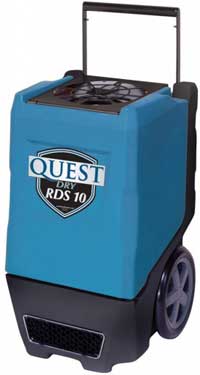
There are cheaper models on the market, but you really do get what you pay for. If you’re looking for the very best grow room dehumidifier, then look no further. This is hands-free, “set and forget” technology that you’ll only need to check in on once in a great while.
The Quest name is well known in the industry, and the company makes some of the best dehumidifiers in the business. This model is an excellent example of the features and workmanship you can expect from a Quest dehumidifier. An outstanding machine all around.
Soleus Air HCT-D70 Grow Room Dehumidifier
The first thing to understand about a grow room dehumidifier, in general, is the fact that most people won’t need more than a 60-100 pint per day capacity. If you need more than that, you’re probably engaging in a commercial enterprise and have a lot more than just a single, modestly-sized grow room to deal with.
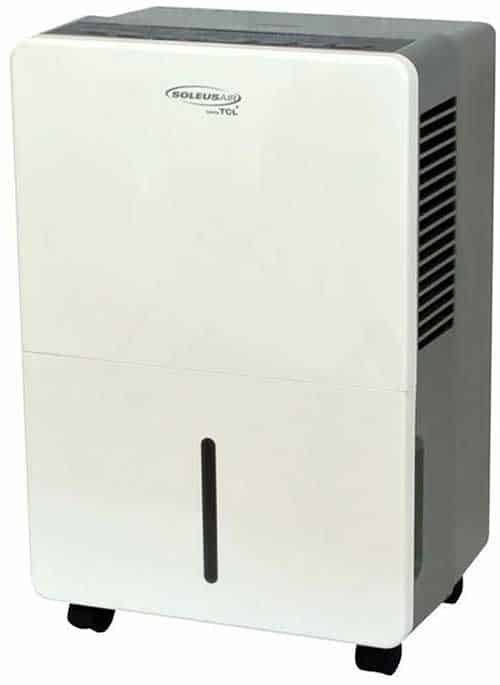
They do make dehumidifiers at a commercial scale, but even the least of those would be far too much for home use. There’s just nothing to be gained in buying more dehumidifying capability than you need.
With that in mind, the Soleus HCT-D70 70-pint dehumidifier is a solid pick that will serve you well. Its built-in humidistat allows for precise humidity control, and its 70-pint capacity is sufficient for the task and will likely be all that you need.
The device is well-priced and energy efficient, carrying an Energy Star rating, but there’s a catch, and it might be a deal breaker for some. Its modest price is because the unit contains no condensate pump.
That means you’ve either got to hook up a garden hose to the device and let gravity drain the water away, or you’ve got to manually empty the 17-pint fill bucket up to 4 times a day (if the machine is operating at maximum capacity).
Fortunately, the Soleus does come with an automatic shutoff when the bucket gets full, so you won’t come home to any nasty surprises on that front. All in all, it’s a solid unit, but the absence of the condensate pump means that we couldn’t select it as our top pick.
Ideal Air 70-Pint Dehumidifier
This unit is similar in many ways to the Soleus we talked about above. Like the Soleus, the Ideal Air 70-Pint Dehumidifier has a 70-pint per day capacity, which should be fine for most users.
Like the Soleus 70-pint dehumidifier, the price is kept low because there’s no condensate pump, although Ideal Air does offer one as part of an upgrade kit.
Even though the pump isn’t included with the standard offering, the fact that it is available makes this model slightly superior to the Soleus. The other thing you’ll appreciate about the Ideal Air model is the impressive 5-year compressor warranty, which is the best in the industry, and makes Ideal Air’s offering a solid contender.
Active Air 100 Dehumidifier
The Active Air model is an interesting one and is specifically included because we understand that one size definitely doesn’t fit all. While the market may be smaller for this level of moisture extraction capability, it’s definitely present, and we wanted to include an example of something a bit more robust.
Functionally, the Active Air commercial 100 pint dehumidifier is similar to the Ideal Air model we mentioned above but with greater extraction capabilities, which is reflected in this unit’s higher price.
Unfortunately, it still lacks a built-in condensate pump. That, plus the fact that it’s more dehumidifier than many home users will need, are the only two things that kept it from being our top pick. This unit, as with all the ones we’ve talked about here, comes with a built-in humidistat.
References & Resources
- Eva-Dry, Official Brand Website.
- Ivation, Official Brand Website.
- Gurin, Official Brand Website.
- hOmeLabs, Official Brand Website.
- EdgeStar, Official Brand Website.
- Yaufey, Official Brand Website.
- Honeywell, Official Brand Website.
- Frigidaire, Official Brand Website.
- Haier, Official Brand Website.
- Quest, Official Brand Website.
- Keystone, Official Brand Website.
